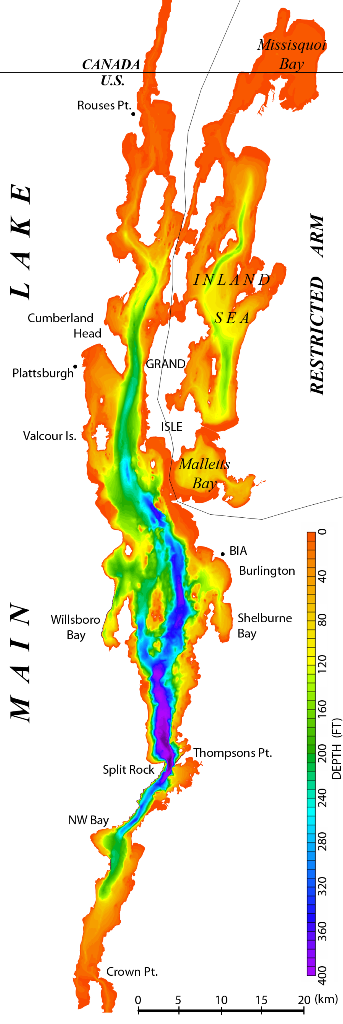Lake Champlain is a 435-square-mile lake bordering Vermont, New York, and Quebec and center of the region’s ecosystems. It is the sixth largest freshwater body in the United States. The lake is a historic waterway and the birthplace of the US Navy. Strategic naval battles have been fought on it, such as the Battle of Valcour Island during the Revolutionary War and the Battle of Plattsburgh during the War of 1812.
 Geologically, Lake Champlain is subdivided into five distinct sub-basins. The South Lake, which runs north from Whitehall, NY to Crown Point, is narrow, shallow, and turbid, like a river; infestation by exotic invasive plants (Eurasian milfoil and water chestnuts) has rendered some stretches marshlike.
Geologically, Lake Champlain is subdivided into five distinct sub-basins. The South Lake, which runs north from Whitehall, NY to Crown Point, is narrow, shallow, and turbid, like a river; infestation by exotic invasive plants (Eurasian milfoil and water chestnuts) has rendered some stretches marshlike.
The Main Lake, which encompasses the broadest part of the lake, holds more than 80% of the lake’s volume and runs from Crown Point north to Rouses Point, where it flows into the Richelieu River on its way to the St. Lawrence River. The Main Lake is roughly 400 feet at its deepest, and the water is clear and cold.
The Restricted Arm on the lake’s eastern side consists of three areas. Malletts Bay is a small bay on the south end of the Restricted Arm. The Inland Sea, also known as the Northeast Arm, sits north of Malletts Bay; much of this sub-basin is of intermediate depth, cool, and clear. Missisquoi Bay, at the northern end, is very shallow (less than 15 feet) and is affected by large-scale algal blooms.
The geological, chemical, physical, and biological diversity of the three sections—Main Lake, South Lake, and Restricted Arm—makes Lake Champlain an interesting example of large-lake ecology. The region hosts impressive biological diversity: 81 fish, 20 reptile and amphibian, 318 bird, and 56 mammal species inhabit the lake and its watershed.
Lake Champlain is the major source of drinking water for roughly 200,000 people in over 20 towns and cities in Vermont, New York, and Quebec. Centuries of human habitation in the basin have made toxics a concern; the region holds 34 hazardous-waste sites and 95 landfills, and fish consumption advisories (for mercury and PCBs) have been issued for four fish species in the lake. The region thus presents extensive opportunities for research and is a perfect laboratory for many disciplines. Compared to the Great Lakes, however, Lake Champlain remains under-studied.
